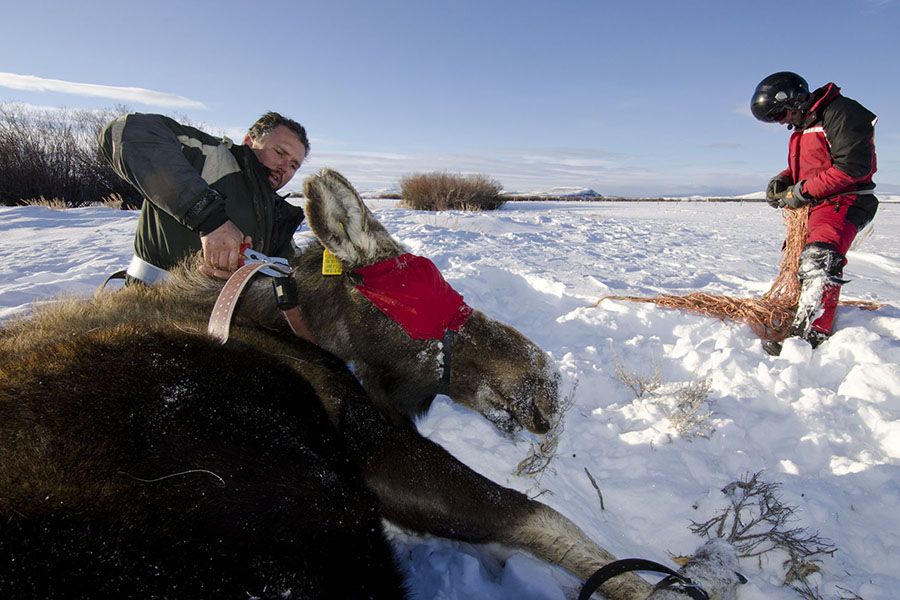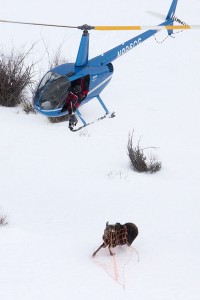
By Kelsey Dayton
A study on Wyoming’s largest moose herd could guide management decisions about oil and gas leasing in the Wyoming Range, south of Grand Teton National Park.
The Wyoming Game and Fish Department, and the Wyoming Cooperative Fish and Wildlife Research Unit recently expanded a moose project in the Northern Wyoming Range between Jackson and Pinedale.
Researchers collared 65 moose and fitted the animals with satellite tracking collars during the past three years to learn about their use of habitat, migration patterns and survival. An additional 28 cows were fitted with collars this winter between Cottonwood Creek and the upper Hoback River. Of those, 12 are wearing collars that provide real-time daily locations, a press release said. The other collars are set to fall off after two years and then the data can be downloaded. This winter, researchers also documented body condition using ultrasounds of rump fat.
“It’s pretty cutting edge stuff,” said Mark Gocke, with Wyoming Game and Fish.
While other animals, like mule deer and elk, have been studied in relationship to oil and gas development, moose haven’t. Moose in some areas of the state, like in the Snowy Range or the Big Horns have been thriving. But in western Wyoming, herds have struggled.
The study is trying to figure out what changes are happening in the herd and what are the causes, Gocke said.
“It’s going to be pretty enlightening information for everybody,” he said.

The study originally started as a way to gather baseline data on the moose population, including nutrition, migratory routes and times, as well as winter and summer range, before Plains Exploration and Production Co. (PXP) began plans to develop oil and gas leases in the area, said Jake Goheen, assistant professor in zoology and physiology at the University of Wyoming.
The Sublette Moose herd is the largest in the Intermountain West in the lower 48 states, he said. Since research began, PXP sold its leases to the Trust for Public Land, which raised money through donations to buy and retire the leases from future development. With the PXP leases retired, focus has now shifted to 44,700 acres that were leased before the Wyoming Range Legacy Act passed in 2009 and retired 1.2 million acres in the Wyoming Range from oil and gas development. The legislation left the fate of those acres up to the agencies, and Bridger-Teton National Forest staff are still studying the acreage and haven’t yet issued a decision. Recent interest from Stanley Energy in exploring within those acres could threaten moose, Goheen said. The Bridger Teton National Forest is currently analyzing possible alternatives for the proposed development that includes South Beaver, North Horse, and Cottonwood creeks in a Supplemental Environmental Impact Statement (SEIS).
Although moose are relatively abundant in this area, very little is known about their demography or habitat use.
The expanded study, which focuses on moose south of the original study area, is an attempt to gather baseline data on the herd, Goheen said. The information will provide land managers with the best possible science as they evaluate projects in the area.
“This isn’t really a question about will energy development disturb moose,” Goheen said. “The answer is most likely yes. The question is how we can mitigate those impacts if development occurs.”
The study is unusual in that it is proactive, he said. Often wildlife management is reactive. Having data ahead of time will help managers find the way to limit impacts on the moose herd if the area is developed.
The study has already yielded surprises. First, the Sublette Moose population has a low pregnancy rate, about 74 percent this year, and when averaged with even lower rates in the previous years, it is the lowest documented rate in the lower 48 states and much lower than the Jackson moose herd, commonly at 90 percent, he said. But the calf survival rate in the Sublette herd is higher than the Jackson herd, he said.
The herd also appears to be partially migratory, meaning some move, but some — about 40 percent from an initial small sample — stay in the same place, which is unusual, Goheen said. That means researchers need to look at the habitat conditions of the area. They also need more data from a larger sample size, he said.
The study is important because it will help show why pregnancy rates are low in the herd, because it separates nutrition and predation as factors, said Steve Kilpatrick, executive director with the Wyoming Wildlife Federation. The study will provide a clearer understanding about what is driving calf-cow ratios, he said.
“Anytime a species is having lower reproductive rates than expected, we want to know why it’s happening,” he said.
It also offers important baseline data on the health of the herd before outside factors like development.
“Pregnancy rates show that those moose are obviously under some sort of stress,” he said. “If we add another stressor, like energy development, then we have some baseline information to compare pre- and current development.”
Even if the area isn’t developed, the data on the herd is important because little ecology information on it existed. Moose are a sensitive species and often a good sensor for changes in the environment.
“If we are doing something wrong, they’ll be one of the first ones to show us,” he said.
Many of Wyoming’s moose populations have suffered marked declines over the past several decades, particularly in the western part of the state, according to Game and Fish. After experiencing a sharp decline that started during the mid-1990s, the Sublette herd stabilized, though numbers remain below the herd population objective set by Wyoming Game and Fish Department. The Sublette moose herd is the largest in the western United States, with about 5,000 animals spanning an area from Hoback Junction to LaBarge to Pinedale to Afton. Those moose bring in tourism dollars from hunters, photographers and wildlife enthusiasts, while also maintaining an important role in the ecosystem, Goheen said. “They are important to the ecology and the economy of the area.”
Plus, Kilpatrick added, everyone likes moose. “They are so darn ugly they’re cute and they cause little conflict with land owners.”
This piece was originally published on WyoFile.com in Peaks to Plains, a blog focusing on Wyoming’s outdoors and communities. Kelsey Dayton is a freelance writer based in Lander. She has been a journalist in Wyoming for seven years, reporting for the Jackson Hole News & Guide, Casper Star-Tribune and the Gillette News-Record. Contact Kelsey at [email protected]. Follower her on twitter @Kelsey_Dayton.
